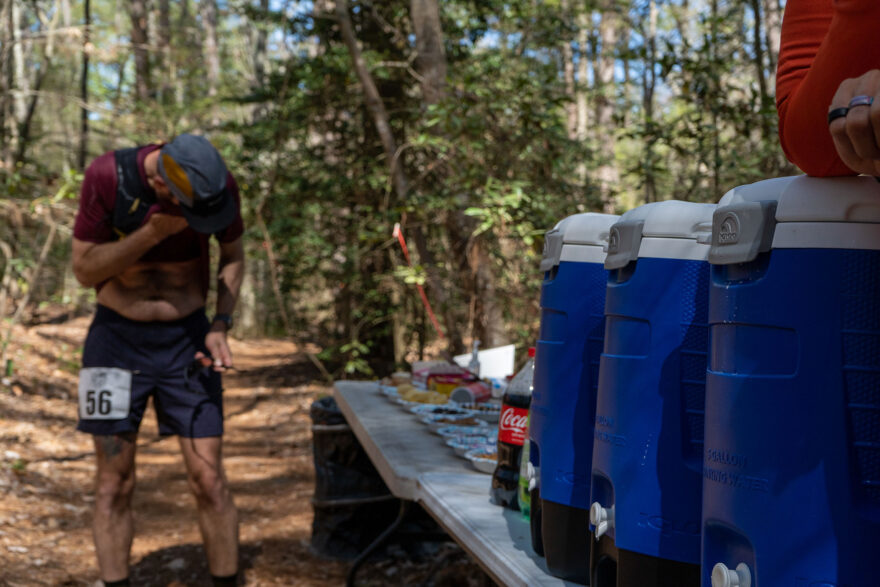
Image courtesy of Tara Dower
Everybody sweats — but not everybody sweats the same. Some people soak their clothes on a one mile run, while others will finish 20 with barely a sheen to show for it. So it’s not all about how much you sweat. The electrolyte makeup of your sweat differs from one person to the next.
For endurance athletes, that’s more than just a fun fact. Sweat serves as data about an individual’s nutritional needs. It speaks volumes to the status of electrolyte balance in your body, how much of those minerals you lose through exertion, and what kind of hydration strategy you need to account for the losses to keep from getting bogged down by dehydration.
Without the right strategy based on your unique breed of sweat, you’ll inevitably experience your fair share of run-ruiners like cramps and emergency trailside bathroom breaks.
Test Your Sweat
Given that no two people sweat the same, generalized hydration recommendations only go so far. Following generic advice on fluid intake and electrolyte balance might cause athletes to drastically under- or over-hydrate, both of which trigger similar physical side-effects: fatigue, headache, nausea, confusion, bloating, respiratory difficulties, and kidney dysfunction. Not exactly a recipe for high performance (or a good time).
Endurance sports dietitian Alyssa Lieb of Peak to Peak Nutrition explains that “during exercise, sweat rate can range from 0.5 to 2 liters per hour (or beyond!), so blanket guidelines may meet the needs of the average athlete … but most individuals are going to fall either above or below these recommendations.”

ActionHub editor Ryan Tipps is covered in salt excretions during a 60k race in Virginia Beach. (Image courtesy of Tara Dower)
The only true way to know you’re giving your body what it needs is through a sweat test. Sweat tests measure the concentration of sodium, which Lieb denotes as the most prominent electrolyte present in your sweat.
According to research on individual sweat sodium concentration, that amount can vary greatly from person to person. Lieb expounds on that, clarifying that sodium concentration falls anywhere on a wide range from 200mg per liter of sweat to a whopping 2000mg per liter. It doesn’t say anything about your fitness, your health, or your ability. Your personal sodium concentration depends more on genetics than anything else.
Finding out can only help you make smarter hydration and nutrition choices that support your individuality. Replacing the appropriate amount of sodium during physical activity can lead to significant performance improvements, as seen in research on triathletes who saved 26 minutes on their race times.
The Sweat Test Experience
I met with the Precision Fuel & Hydration team for a sweat test after experiencing debilitating gastrointestinal distress after my long runs that lasted for hours — if not days — after finishing. I honestly expected them to tell me that I was consuming too much sodium since I’ve never been much of a heavy sweater. I’m that annoying friend who finishes a hard workout looking like they haven’t even warmed up yet (but trust me, I’m dying on the inside).
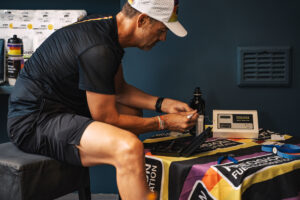
Image courtesy of Precision Fuel & Hydration
I assumed that a light sweat rate correlated with low sodium concentration too. Maybe the standard “16 ounces and 300mg per hour” advice was turning my stomach into a painfully sloshy mess. I’d started to cut back on my electrolyte intake based on this assumption.
The test itself was simple. Unlike some sweat tests that have subjects literally work up a sweat while wearing an absorbent patch, Precision’s test doesn’t require any physical activity. It uses chemicals applied to the skin that “mimic the effect of certain neurotransmitters and stimulate the sweat glands” at rest, according to CEO Andy Blow. This method takes much less time and energy than the patch method, controls the variables better, and produces faster results. The whole process shouldn’t take more than 45 minutes max.
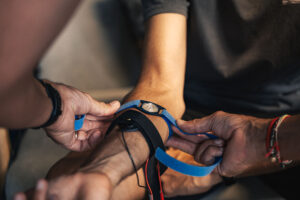
Image courtesy of Precision Fuel & Hydration
Mine barely took 15. That should have been the first sign that my hypothesis was questionable at best. The test revealed that I couldn’t have been more wrong about my sweat.
Instead of sitting on the low end of the spectrum, I came in at the very top with a sodium concentration rate of 1801 mg per liter. This was noteworthy enough to interest Blow himself in my results. He initially founded Precision Fuel & Hydration after realizing that his own higher than average sodium concentration level was the cause of a stubborn struggle with cramps throughout his triathlon training. His body needed a different hydration strategy than the generic prescription.
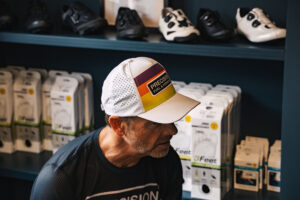
Andy Blow is CEO of Precision Fuel & Hydration. (Image courtesy of Precision Fuel & Hydration)
Blow aimed to help other athletes place themselves on the spectrum and give them options depending on how they scored, so they didn’t have to rely on blind assumptions about their needs that may or may not actually serve them. There aren’t too many of us so high up there, he said, so he wanted to meet another member of the club.
That’s a club I never would have known I belonged in without getting the hard data. My relatively low sweat volume tricked me into thinking my struggles stemmed from too much sodium, not too little.
I learned that day that sweat volume and sweat composition don’t actually have that much to do with one another. Now, I could target my needs in both arenas rather than erroneously conflating them and causing my own discomfort.
Personalized Hydration
When you know better, you can do better. Now that I understood the nature of my sweat, I could treat it with the respect it deserved all along. That meant taking in a higher concentration of sodium to match the amount lost during exertion. Most electrolyte supplements supply around 600-700 mg of sodium per liter of fluid, which is less than half of the amount that I lose per liter of sweat. That’s not nearly enough sodium to adequately replenish myself and fight off fatigue, cramping, nausea, and the whole host of symptoms that had plagued me. No wonder my body wasn’t happy with me.
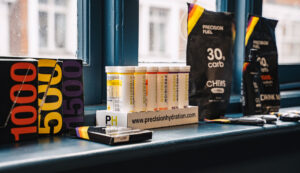
Image courtesy of Precision Fuel & Hydration
I’ve since shifted to PH1500, Precision’s highest sodium formula, as my main electrolyte supplement. As the name suggests, it provides 1500mg of sodium per liter. I can make up the rest with supplemental electrolyte capsules. From there, I can tailor the volume of fluid to match how much sweat I produce based on exertion and my environment. The sweat test experience comes with a personalized hydration plan that helps you determine those amounts within the context of training, racing, and everyday life.
For those that aren’t quite so exceptional in the sodium department, Precision has the low end of the spectrum covered as well. PH250 takes care of very minimally salty sweaters, while PH500 works for the average Joe and PH1000 creeps toward a strong dose.

Consultation with a client at Precision Fuel & Hydration. (Image courtesy of Precision Fuel & Hydration)
But before you choose, do yourself a favor and find out for sure what your sweat has to say about the matter. Guesswork isn’t worth the risk of shortchanging yourself. It’s hard enough on your body to run, bike, and swim your way to meeting big athletic goals; don’t let ignorance make it harder — if not impossible.
Sweat Through the Seasons
Runners are more likely to worry about hypothermia than dehydration during colder months, but because athletes don’t think as much about sweat in the winter, they many end up struggling even more with electrolyte imbalance during that time of the year. Sweat rate might change with the seasons while sodium concentration remains the same no matter the weather outside. This means that your body still requires the same amount of electrolyte replenishment across all climates. Plus, sweat can hide beneath the layers upon layers of clothing you wear to stay warm for winter runs and dry (or freeze) before you notice.
Just because you can’t see the sweat doesn’t mean it isn’t happening. Cold temperatures also tend to dull thirst cues — so unless you’re vigilant about hydration all year round, you’re likely to fall short.
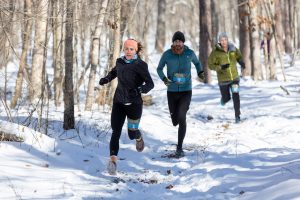
Trail runners come down the home stretch of a winter-season 10-mile race. (Image by Jay Proffitt Creative Media)
Even if winter didn’t present its own challenges for hydration, though, this is an important time of year to practice the fueling strategies that will carry you through summer. It’s better to build a baseline when the consequences may not be as high than it is to play catch-up when the temperatures start to rise.
The body doesn’t like surprises, especially when it comes to how you fuel it. You’ll benefit later from giving your body ample time now to adjust.
Lucie Hanes is an avid writer and adventurer on rock and trail with a passion for sharing her outdoor enthusiasms through journalism and mental strength consultation.

 Your Privacy Choices
Your Privacy Choices
 The
The